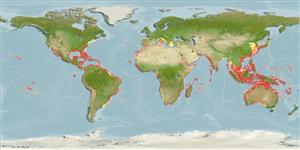Classification / Names
Common names from other countries
Main reference
Size / Weight / Age
Max length : 275 cm TL male/unsexed; (Ref. 27169); common length : 150 cm TL male/unsexed; (Ref. 9253); max. published weight: 122.8 kg (Ref. 4699); max. reported age: 12 years (Ref. 244)
Length at first maturity
Lm ?, range 120 - 194 cm
Environment
Marine; brackish; reef-associated; amphidromous (Ref. 51243); depth range 0 - 100 m (Ref. 89972), usually 0 - 30 m (Ref. 55184)
Climate / Range
Subtropical, preferred 27°C (Ref. 107945); 45°N - 38°S, 166°W - 171°E (Ref. 55184)
Distribution
Cosmopolitan. Western Atlantic: Nova Scotia, Canada to Brazil (Ref. 26340). Eastern Atlantic: Senegal to Democratic Republic of the Congo, Madeira, the Canary Islands, and Mediterranean. Indo-Pacific: Persian Gulf (Ref. 68964), Red Sea, Madagascar and South Africa to China, Australia, Tahiti, Marquesas, and Hawaii. Eastern Pacific: Baja California, Mexico to Peru, including the Galapagos Islands.
Countries | FAO areas | Ecosystems | Occurrences | Introductions
Short description
Dorsal
spines
(total): 0;
Dorsal
soft rays
(total): 0;
Anal
spines: 0;
Anal
soft rays: 0. A stout shark with a long, narrow, pointed snout, long gill slits and erect, narrow-cusped upper teeth; first dorsal fin high; no interdorsal ridge (Ref. 5578). Dark grey, ashy blue or dusky bronze on back, belly white or yellowish white; a dark band extending rearward along each side to about over origin of pelvic fin; tips of pelvic fins with a persistent black spot; tips of dorsal fins, pectoral fins, anal, and lower lobe of caudal fin usually black or dusky in young individuals, fading with growth (Ref. 9997).
IUCN Red List Status (Ref. 115185)
Human uses
Fisheries: commercial; gamefish: yes
Tools
Special reports
Download XML
Internet sources
Estimates of some properties based on models
Phylogenetic diversity index
PD50 = 0.5000 many relatives (e.g. carps) 0.5 - 2.0 few relatives (e.g. lungfishes)
Trophic Level
4.4 ±0.4 se; Based on diet studies.
Resilience
Low, minimum population doubling time 4.5 - 14 years (rm=0.054; K=0.27; tm=3-8; tmax=18; Fec=1-10)
Vulnerability
High vulnerability (55 of 100)
Price category
